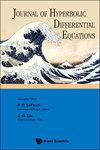双分量非线性变分波系
IF 1.1
4区 数学
Q4 MATHEMATICS, APPLIED
引用次数: 0
摘要
本文导出了非线性变分波动方程的一种新的双分量推广方法,作为变阶参数向列液晶指向场的模型。该方程在局部时间上允许经典解。我们证明了一种特殊的半线性情形是全局适定的。我们证明了一个特定的长时间渐近展开式在运动坐标系中围绕一个恒定状态满足双分量Hunter-Saxton系统。本文章由计算机程序翻译,如有差异,请以英文原文为准。
A two-component nonlinear variational wave system
We derive a novel two-component generalization of the nonlinear variational wave equation as a model for the director field of a nematic liquid crystal with a variable order parameter. The equation admits classical solutions locally in time. We prove that a special semilinear case is globally well-posed. We show that a particular long time asymptotic expansion around a constant state in a moving frame satisfies the two-component Hunter–Saxton system.
求助全文
通过发布文献求助,成功后即可免费获取论文全文。
去求助
来源期刊

Journal of Hyperbolic Differential Equations
数学-物理:数学物理
CiteScore
1.10
自引率
0.00%
发文量
15
审稿时长
24 months
期刊介绍:
This journal publishes original research papers on nonlinear hyperbolic problems and related topics, of mathematical and/or physical interest. Specifically, it invites papers on the theory and numerical analysis of hyperbolic conservation laws and of hyperbolic partial differential equations arising in mathematical physics. The Journal welcomes contributions in:
Theory of nonlinear hyperbolic systems of conservation laws, addressing the issues of well-posedness and qualitative behavior of solutions, in one or several space dimensions.
Hyperbolic differential equations of mathematical physics, such as the Einstein equations of general relativity, Dirac equations, Maxwell equations, relativistic fluid models, etc.
Lorentzian geometry, particularly global geometric and causal theoretic aspects of spacetimes satisfying the Einstein equations.
Nonlinear hyperbolic systems arising in continuum physics such as: hyperbolic models of fluid dynamics, mixed models of transonic flows, etc.
General problems that are dominated (but not exclusively driven) by finite speed phenomena, such as dissipative and dispersive perturbations of hyperbolic systems, and models from statistical mechanics and other probabilistic models relevant to the derivation of fluid dynamical equations.
Convergence analysis of numerical methods for hyperbolic equations: finite difference schemes, finite volumes schemes, etc.
 求助内容:
求助内容: 应助结果提醒方式:
应助结果提醒方式:


